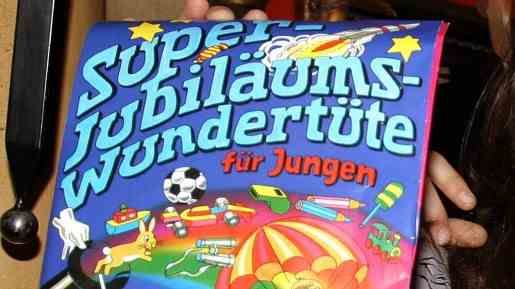The offer reads tempting: Mystery Box Electronics, for 29.40 euros, free delivery. A red gift box is also shown, from which a few streamers are jumping – and televisions, smartwatches or a navigation device. Also in the program: a 50-piece hardware store package or a box with 20 beauty products. Alleged returns or residual items have been advertised by online retailers as beautifully packaged surprise boxes for some time now. In truth, you buy a pig in a poke. And therein lies the attraction.
These surprise boxes follow the principle of a bestseller that has been known for decades: the surprise bag. The paper bags with surprise contents, which were available for a few pfennigs at the kiosk, were already popular with children in the post-war years. First they tried to feel it, then they tore open the bag with a rattle and were happy about a few sour snakes, sweets and trading cards or a small toy figure.
The recipe for success of the piñata is: feel happiness through excitement. “It’s similar to gambling,” explains Marko Sarstedt, Professor of Marketing at the Ludwig Maximilian University in Munich. “Just the expectation of finding something great in the bag releases happiness hormones.”
A Smurf for 20,000 euros
The surprise bags for children are still there. They no longer cost pennies, but several euros, the principle is more sophisticated and in many cases is aimed at the desire to complete a collection. The surprise eggs from Ferrero (which have fallen into disrepute because of the danger of salmonella) are basically nothing more than surprise bags, and they are not only popular with children: collectors shell out five-digit sums for many a figure from the yellow plastic capsule – the night watchman smurf from 2008, for example, is currently worth 20,000 euros.
The Ü-Ei figures “Crazy Crocos” from the 1990s are comparatively cheap – but who knows, maybe their value will increase.
(Photo: Christoph Hardt/Imago/Future Image)
Toy manufacturers such as Lego and Playmobil have long copied this surprise egg logic: they sell figures from a specific series in opaque bags without you knowing in advance which plastic doll you are getting. A hugely promotional tactic that works a bit like a no-nonsense raffle where the top prize is known, in this case your favorite character.
A surprise bag can also have the shape of a suitcase. Airports are auctioning off luggage left unclaimed for three months. As a new owner, you don’t know whether it might contain a valuable piece of jewelery or just dirty socks. After all, customs officials check the contents of the suitcase before the auction, so that you don’t accidentally buy a kilo of cocaine.
This kind of piñata is less about business, often the airport operators donate the proceeds of the auctions to charity. The idea behind it is also to protect the contents of the case from disposal. However, sustainability only works to a limited extent, because the new owners are then allowed to throw away the dirty socks and many other things.
Moments of surprise in well-planned everyday life
The example shows that the piñata principle also works for adults. They buy for nostalgic reasons, because they feel reminded of good experiences from their childhood, “but also out of the need to treat themselves to something in between,” says marketing expert Sarstedt. “In the well-planned everyday life you create a few rare surprise elements.”
Sarstedt differentiates between two types of buyers: those who take risks and focus on profits, and those who want to avoid losses. Of course, only the risky type would dare to invest in what might turn out to be a pile of junk in the hope of snagging something great. The typical bargain hunter.
What about the remaining stock sales on Amazon? Is it simply a matter of selling junk and fueling the greed is cool mentality, or is there a lasting idea behind the surprise boxes? A bit of both, judges Sarstedt. The boxes are a good way to keep remaining stock from being destroyed. “But the problem is only being postponed,” says Sarstedt. Ultimately, the buyer of the beauty box will throw away all the lipsticks she doesn’t like. The surprise boxes are primarily used to create storage space – for new products.

